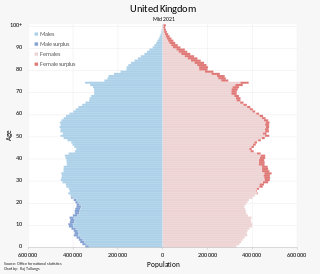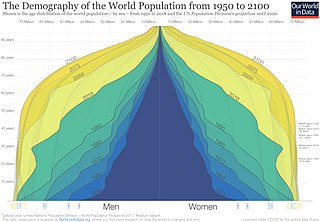Related Research Articles

Human life expectancy is a statistical measure of the estimate of the average remaining years of life at a given age. The most commonly used measure is life expectancy at birth. This can be defined in two ways. Cohort LEB is the mean length of life of a birth cohort and can be computed only for cohorts born so long ago that all their members have died. Period LEB is the mean length of life of a hypothetical cohort assumed to be exposed, from birth through death, to the mortality rates observed at a given year. National LEB figures reported by national agencies and international organizations for human populations are estimates of period LEB.

The population of the United Kingdom was estimated at over 67.0 million in 2020. It is the 21st most populated country in the world and has a population density of 270 people per square kilometre, with England having significantly greater density than Wales, Scotland, and Northern Ireland. Almost a third of the population lives in south east England, which is predominantly urban and suburban, with about 9 million in the capital city, London, whose population density is just over 5,200 per square kilometre.

Demography is the statistical study of human populations: their size, composition, and how they change through the interplay of fertility (births), mortality (deaths), and migration.

The United States had an official estimated resident population of 334,914,895 on July 1, 2023, according to the U.S. Census Bureau. This figure includes the 50 states and the District of Columbia but excludes the population of five unincorporated U.S. territories as well as several minor island possessions. The United States is the third most populous country in the world. The Census Bureau showed a population increase of 0.4% for the twelve-month period ending in July 2022, below the world average annual rate of 0.9%. The total fertility rate in the United States estimated for 2022 is 1.665 children per woman, which is below the replacement fertility rate of approximately 2.1.

According to data from the 1989 Soviet census, the population of the USSR was made up of 70% East Slavs, 17% Turkic peoples, with no other single ethnic group making up more than 2%. Alongside the atheist majority of 60%, there were sizable minorities of Russian Orthodox Christians and Muslims.

Mortality rate, or death rate, is a measure of the number of deaths in a particular population, scaled to the size of that population, per unit of time. Mortality rate is typically expressed in units of deaths per 1,000 individuals per year; thus, a mortality rate of 9.5 in a population of 1,000 would mean 9.5 deaths per year in that entire population, or 0.95% out of the total. It is distinct from "morbidity", which is either the prevalence or incidence of a disease, and also from the incidence rate.

In actuarial science and demography, a life table is a table which shows, for each age, the probability that a person of that age will die before their next birthday. In other words, it represents the survivorship of people from a certain population. They can also be explained as a long-term mathematical way to measure a population's longevity. Tables have been created by demographers including John Graunt, Reed and Merrell, Keyfitz, and Greville.

In demography and medical geography, epidemiological transition is a theory which "describes changing population patterns in terms of fertility, life expectancy, mortality, and leading causes of death." For example, a phase of development marked by a sudden increase in population growth rates brought by improved food security and innovations in public health and medicine, can be followed by a re-leveling of population growth due to subsequent declines in fertility rates. Such a transition can account for the replacement of infectious diseases by chronic diseases over time due to increased life span as a result of improved health care and disease prevention. This theory was originally posited by Abdel Omran in 1971.
The Global Burden of Disease Study (GBD) is a comprehensive regional and global research program of disease burden that assesses mortality and disability from major diseases, injuries, and risk factors. GBD is a collaboration of over 3600 researchers from 145 countries. Under principal investigator Christopher J.L. Murray, GBD is based in the Institute for Health Metrics and Evaluation (IHME) at the University of Washington and funded by the Bill and Melinda Gates Foundation.

The Hispanic paradox is an epidemiological finding that Hispanic Americans tend to have health outcomes that "paradoxically" are comparable to, or in some cases better than, those of their U.S. non-Hispanic White counterparts, even though Hispanics have lower average income and education, higher rates of disability, as well as a higher incidence of various cardiovascular risk factors and metabolic diseases.

The ageing of Europe, also known as the greying of Europe, is a demographic phenomenon in Europe characterised by a decrease in fertility, a decrease in mortality rate, and a higher life expectancy among European populations. Low birth rates and higher life expectancy contribute to the transformation of Europe's population pyramid shape. The most significant change is the transition towards a much older population structure, resulting in a decrease in the proportion of the working age while the number of the retired population increases. The total number of the older population is projected to increase greatly within the coming decades, with rising proportions of the post-war baby-boom generations reaching retirement. This will cause a high burden on the working age population as they provide for the increasing number of the older population.

In epidemiology, the excess deaths or excess mortality is a measure of the increase in the number deaths during a time period and/or in a certain group, as compared to the expected value or statistical trend during a reference period or in a reference population. It may typically be measured in percentage points, or in number of deaths per time unit.

Healthcare in Europe is provided through a wide range of different systems run at individual national levels. Most European countries have a system of tightly regulated, competing private health insurance companies, with government subsidies available for citizens who cannot afford coverage. Many European countries offer their citizens a European Health Insurance Card which, on a reciprocal basis, provides insurance for emergency medical treatment insurance when visiting other participating European countries.

Malaysia is classified by The World Bank as upper middle income country and is attempting to achieve high-income status by 2020 and to move further up the value-added production chain by attracting investments in high technology, knowledge-based industries and services. Malaysia's HDI value for 2015 was recorded at 0.789 and HDI rank no 59 out of 188 countries and territories on the United Nations Development Programme's Human Development Index. In 2016, the population of Malaysia is 31 million; Total expenditure on health per capita is 1040; Total expenditure on health as % of GDP (2014) was 4.2 Gross national income (GNI) per capita was recorded at 24,620

The Tajikistan health system is influenced by the former Soviet legacy. It is ranked as the poorest country within the WHO European region, including the lowest total health expenditure per capita. Tajikistan is ranked 129th as Human Development Index of 188 countries, with an Index of 0.627 in 2016. In 2016, the SDG Index value was 56. In Tajikistan health indicators such as infant and maternal mortality rates are among the highest of the former Soviet republics. In the post-Soviet era, life expectancy has decreased because of poor nutrition, polluted water supplies, and increased incidence of cholera, malaria, tuberculosis, and typhoid. Because the health care system has deteriorated badly and receives insufficient funding and because sanitation and water supply systems are in declining condition, Tajikistan has a high risk of epidemic disease.

The quality of health in Cambodia is rising along with its growing economy. The public health care system has a high priority from the Cambodian government and with international help and assistance, Cambodia has seen some major and continuous improvements in the health profile of its population since the 1980s, with a steadily rising life expectancy.
Health in Russia deteriorated rapidly following the dissolution of the Soviet Union, and particularly for men, as a result of social and economic changes.
Zambia is a landlocked country in Sub Saharan Africa which experiences a burden of both communicable and non-communicable diseases. In line with WHO agenda for equity in health, it has adopted the Universal Health Coverage agenda to mitigate the challenges faced within the health sector. The Ministry of Health (MOH) provides information pertaining to Zambian health. The main focus of the Ministry of Health has been provision of uninterrupted care with emphasis on health systems strengthening and services via the primary health care approach.

Australia has an ageing demographic. The proportion of the Australian population aged 65 and over was 15% in 2017, a trend which is expected to continue to grow. It is estimated that by 2057 older people will account for 22% of the Australian population which translates to 8.8 million people. This increase in elderly population is due to what is known as The Australian Baby Boom. This period refers to the post-war era in which total fertility rates (TFR) were approximately 3.0, resulting in 4.19 million births recorded. This number exceeded the number of births in Australia from the previous 20 years in which there were 1.63 million births, and the proceeding 20 years in when 2.56 million births were recorded. The baby boom children will be celebrating their 65th birthday between 2011 and 2030, the age which is referred to as elderly.
References
- 1 2 3 Keyfitz, Nathan (November 1977). "What Difference Would It Make if Cancer Were Eradicated? An Examination of the Taeuber Paradox". Demography. 14 (4): 411–418. doi: 10.2307/2060587 . JSTOR 2060587. PMID 913728.
- ↑ "Population Association of America".
- ↑ Mitra, S. (November 1978). "A Short Note on the Taeuber Paradox". Demography. 15 (4): 621–623. doi: 10.2307/2061211 . JSTOR 2061211. PMID 738485.
- ↑ Keyfitz, Nathan; Caswell, Hal (2005). Applied mathematical demography (3rd. ed.). Springer. p. 81. ISBN 0-387-22537-4.
- ↑ National Center for Health Statistics (U.S.) (September 1999). U.S. decennial life tables for 1989-91. Volume 1, Number 4, United States Life Tables Eliminating Certain Causes of Death (PDF). Hyattsville, Md. : U.S. Dept. of Health and Human Services, Centers for Disease Control and Prevention, National Center for Health Statistics; Washington, D.C. pp. 143–147. Retrieved 21 June 2020.